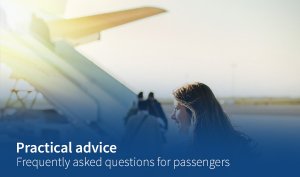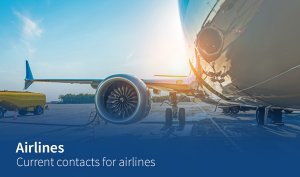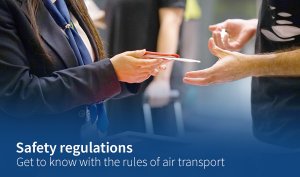General information
How to prepare for the security check?
The security check is carried out to ensure the safety of passengers at the airport and during the flight.
- The security check usually opens 2 hours before the scheduled departure, usually directly following the opening of a specific airline at the check-in counters on the ground floor in the departure hall. Always arrive at the security check on time.
Liquids
- Prepare all liquids in the comfort of your home to avoid delays or stress at the airport.
Liquids include: all types of liquids, aerosols and gels such as water, drinks, creams, sprays, toothpastes, hair gels, shaving gels and foams, soups, syrups, perfumes and other items of similar consistency.
This also includes some types of food such as jam, honey, nutella, pâté, bryndza, processed cheese, baby food, etc...
Maximum quantity limit per passenger: Liquids, aerosols and gels are carried in separate containers with a maximum volume of 100 milliliters or an equivalent volume, placed in one transparent plastic bag with a maximum volume of 1 liter that can be resealed, with the contents of this plastic bag fits into it without any problems and the bag is completely closed.
WARNING! Important is the size of the package, not how much liquid is in the package.
Exceptions include: medicines, liquids transported for health reasons or special dietary requirements, including baby food (baby porridges, soups, whipped meals, liquids in the child's drinking regime, etc.) in the expected amount required for the duration of the flight. Inform the security staff in advance about the transport of baby food.
Liquids, aerosols and gels in separate containers with a maximum volume of 100 milliliters or an equivalent volume do not need to be removed from hand baggage.
The passenger is obliged to remove liquids, aerosols and gels from hand baggage into the security crate and present them for inspection:
- with a volume over 100 ml;
- packed in a provably intact sealed security bag (STEB) with visible proof of purchase inside the bag;
- necessary for health reasons, or due to special dietary requirements, including baby food, and intended for use during the trip with a volume of over 100 ml;
Security staff may ask the passenger to remove the liquid, aerosol or gel for additional screening.
All other liquids must be placed in checked baggage.
Electronics
Larger electronics (notebook, book reader, tablet, power bank, camera, etc.) do not need to be removed from hand luggage.
Strollers
Strollers are normally checked in at the oversized baggage desk on the ground floor of Terminal A.
- Before handing over each stroller, it is necessary to properly mark it with a luggage tag during a visit to the check-in desk of your airline.
The exception is marking the stroller directly at the boarding gate if the stroller was not marked at the check-in counter in the reserved time.
- If necessary, it is possible, after agreement with the check-in staff, to mark the stroller, not hand it in right away, and take it through the boarding gate to the plane as part of the longer availability of the stroller for the accompanied child.
- If the stroller passes through the security check, it is necessary to fold the stroller before the X-ray check. If the stroller does not fit into the X-ray, it is checked in another way. You will then hand the stroller over to the airport staff below the front aircraft stairs.
Personal belongings
First place the ticket, documents and other light items in a handbag, rucksack or in a pocket of clothing, which you then place in the crate so that they are not caught, damaged or lost during the X-ray process.
- Place your hand baggage in the crate on the sliding belt.
- Take off the upper layers of clothing such as a coat, jacket, etc.
- Remove all things from the pockets, including keys, coins, wallet, mobile phone, but also non-metallic objects, etc.
- Put away your belt, watch, head cover, sunglasses. However, you can keep on you prescription glasses and small jewelry (chains, rings, necklaces).
- Shoes that cover the ankles and higher, shoes with heels, shoes with thick soles and shoes containing visible metal elements (zippers, buckles, decorations, lace fasteners, etc.) must be removed and placed in the crate.
- The passenger is obliged to follow the instructions of the security control employee.
Personal control
All persons must pass through the transit metal detector after being asked by the security control staff. Exceptions are pregnant women or people with a pacemaker. In this case, it is necessary to notify the employee of the security control before the inspection.
- Take all your things from the crate and don't forget anything in it.
- Follow any other instructions from security personnel.
- Commission Implementing Regulation (EU) 2015/1998.
More in this section
| 14:00 | 13:42 | |
| 14:40 | 14:45 | |
| 18:45 |
| 14:50 | 14:50 | |
| 15:30 | 15:30 | |
| 19:15 | 19:15 |
Use of alternative transportation to the Airport
There is a public transport bus to M. R. Štefánik Airport no. 61 in the direction from the main railway station.















